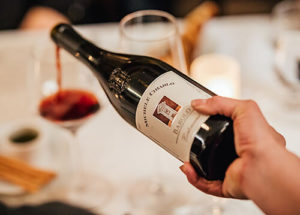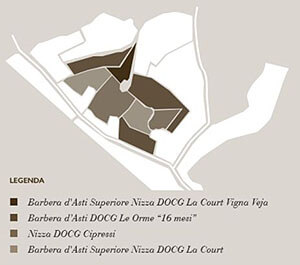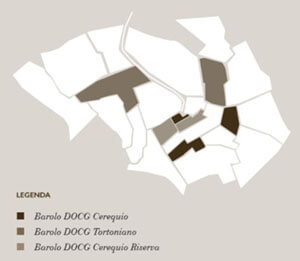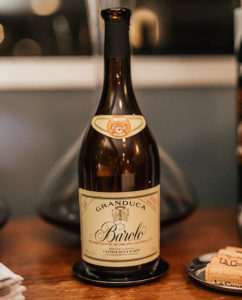[vc_row][vc_column][vc_column_text]
by Deborah Parker Wong / photos by Hardy Wilson
In late January, the wines and seasonal cuisine of Piedmont arrived in San Francisco when Piedmontese winemaker Stefano Chiarlo hosted an evening of celebration at Perbacco marking the anniversary of his father Michele’s 60th harvest.
Stefano Chiarlo relays details of vintage conditions and winemaking practices
as he guides the tasting. Author Deborah Parker Wong is to Chiarlo’s right.
Chiarlo whose father Michele founded the winery in 1956 presented a vertical tasting of the winery’s icon cru Barolo and Barbera wines and several current release wines to accompany a meal that included decadent amounts of tartufo bianco d’Alba, the white truffles of Alba.

The evening unfolded as an experience of the wines in a context that mirrored how they exist in Piedmont. Accompanying Chiarlo was Chef Vincenzo La Corte whose domain is the winery’s Palais Cerequio, a relais located in La Morra inspired by the crus of Barolo. La Corte collaborated with Perbacco Chef Staffan Terje on the four-course anniversary meal.
Chiarlo began the tasting with a vertical of Barbera from the winery’s 20-hectare La Court estate, the largest in Monferrato. The region’s Nizza vineyards were elevated to DOCG status in 2014 and have magnesium-rich, limey sandy soils known as artisane sand. During vinification of the Cipressi Nizza wines, the must cap is gently showered to encourage extraction and the wines are aged in large casks for twelve months.[/vc_column_text][/vc_column][/vc_row][vc_row][vc_column][vc_column_text] Cipressi Nizza 2015 Deeply hued showing blue fruit on the mid palate framed with chocolate, biscuit, earth and leather.
Cipressi Nizza 2015 Deeply hued showing blue fruit on the mid palate framed with chocolate, biscuit, earth and leather.
Cipressi Nizza La Court Superiore 2013
Very opulent, dark-fruited wine with a ferrous and saffron mineral quality. It reflects the ideal vintage conditions in 2013 that resulted in a later harvest and is designated an icon cru.
Cipressi Nizza La Court Superiore 2011
In contrast, 2011 was characterized by an early harvest producing a leaner, savory wine showing more red cherry, slightly higher but balanced alcohol and finishing with drier tannins.
The following flight focused on the icon cru Barolos of Cerequio, is a discontiguous nine-hectare cru site with magnesium-rich, limestone and marl soils that lies between Barolo and La Morra at mid-hill (550 meters).
 Barolo DOCG Cerequio 2013
Barolo DOCG Cerequio 2013
2013 showed higher toned aromas with complex brown spices, garrigue, macerated cherries and notes of balsamic, almond and saffron.
Barolo DOCG Cerequio 2001
Opening with aromas of dark cherry, umami and menthol, Chiarlo characterized the vintage as being “very complete” and the wines being “born soft.”
Barolo DOCG Cerequio 1997
An early, classic Barolo vintage that was accessible in its youth, after two decades the aromas were predominately Bolete mushroom, black tea, leather and bark; a fully-developed, tertiary wine.
Chiarlo attributes the differences in style between the 2013 and 1997 to several factors including greater attention to phenolic maturity and picking decision, longer maceration on the skins from 15 days to 20–25 days and the practice of using a submerged cap.
Dinner was then served and I’ve noted both the wines and the course they were paired with.
Le Orme Barbera di Asti “16 mesi” DOCG 2015
The wine hails from several vineyards Montemareto, La Serra and Costa delle Monache ad Agliano. Fruit-driven and charming, a Barbera that doesn’t take itself too seriously and over delivers on style and quality. Paired with traditional steak tartare showered with the freshest Alba white truffles.
Tortoniano Barolo DOCG 2013
50% of the blend comes from the Cerequio and the remainder from the nearby Tortoniano sites. Aged in medium-sized barrels for two years, the wine has floral notes and shows garrigue as dried herbs and more oak spice with lively red fruit. Paired with risotto served with roasted quail, sweet potato and shaved white truffles.

the first Chiarlo vintage imported to the United States.
Cantine Duca d’Asti Barolo Granduca 1978
The first Chairlo vintage to be imported in to the United States. Winegrowing did not include green harvest, the wines were fermented in cement tanks and aged in Slovenian oak. Notes of guaiacol and smoke were dominant over cherry, leather and mushroom. Paired with the main course of braised veal cheeks with Barolo sauce and apple puree.
Cantine Duca d’Asti Barolo Granduca 1978,
the first Chiarlo vintage imported to the United States.
Nivole Moscato d’Asti 2017
Described by Chairlo as a “sorbet” to cleanse the palate after the meal, the wine was floral, delicate and balanced with an appealing savory finish. Paired with hazelnut parfait, almond cream and cocoa.
A line up of Michele Chiarlo icon cru wines spanning 45 of the winery’s 60 vintages.
The evening concluded with a stroll to The Hidden Vine wine bar where successive vintages and the majority of the winery’s portfolio was poured for the trade.
Felice anniversario, Michele Chiarlo!

[/vc_column_text][/vc_column][/vc_row]
